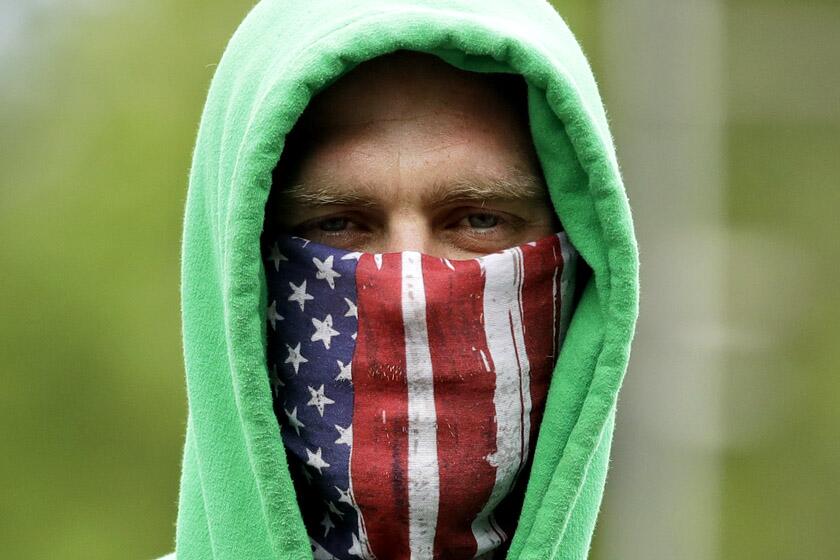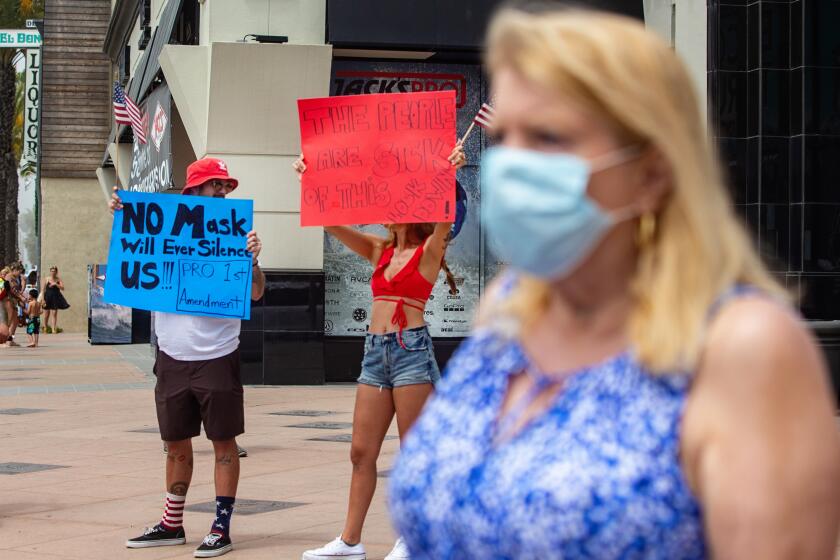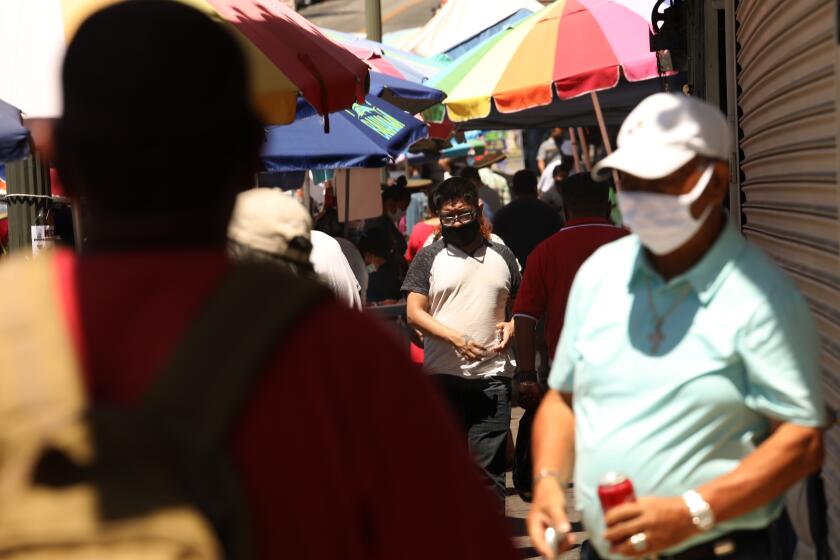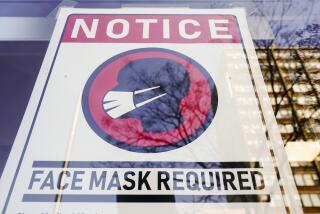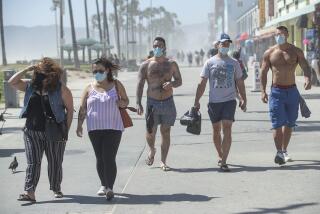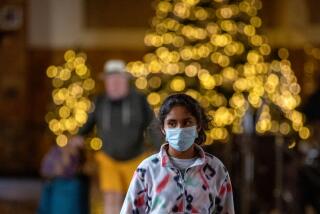T-shirt? Towel? Some experts say it’s time to get beyond states’ anything-goes approach to masks
- Share via
BOULDER, Colo. — Brady Bowman, a 19-year-old student at the University of Colorado Boulder and two friends strolled down 11th Street, all sporting matching orange and white neck gaiters.
He thinks they are just more comfortable to wear than a face mask. “Especially a day like today, where it’s cold out,” he said, with the top of his gaiter pulled down below his chin.
More stylish? Perhaps. More comfortable? Maybe. But as effective? Not necessarily.
With more states requiring face coverings indoors to prevent the spread of COVID-19, gaiters and bandannas have become popular accessories, particularly among college students and other young adults. Less restrictive than masks, they can easily be pulled up or down as needed — and don’t convey that just-out-of-the-hospital vibe.
But tests show those hipper face coverings are not as effective as surgical or cloth face masks. Bandannas, like plastic face shields, allow the virus to escape out the bottom in aerosolized particles that can hang in the air for hours. And gaiters are often made of such thin material that they don’t trap as much virus as cloth masks.
If nearly all Americans would wear face masks when they leave their homes, they could save over 100,000 lives by the end of February, a study says.
As new COVID-19 cases, hospitalizations and deaths surge upward heading into winter, many public health experts wonder whether it’s time to move beyond the anything-goes approach toward more standardization and higher-quality masks. In California, for instance, new guidance that requires most residents to wear face coverings in public settings leaves people the option of using T-shirts, towels or any other cloth that hides the nose and mouth.
President-elect Joe Biden reportedly is mulling a national face-covering mandate of some sort, which could not only increase mask-wearing but also better define for Americans what sort of face covering would be most protective.
“Unlike seat belts, condoms or other prevention strategies, we have not yet standardized what we are recommending for the public,” said Dr. Monica Gandhi, an infectious disease specialist at UC San Francisco. “And that has been profoundly confusing for the American public, to have all these masks on the market.”
Patchwork of regulations
Masks have been shown to reduce the spread of respiratory droplets that contain the coronavirus. And the Centers for Disease Control and Prevention now says that masks not only help prevent people from infecting others but help protect the wearers from infection as well.
According to a recent analysis by the Institute for Health Metrics and Evaluation, implementing universal mask-wearing in late September would have saved nearly 130,000 American lives by the end of February.
The more people see wearing face masks and practicing social distancing as ways to protect the health of others, the more likely they are to comply, research shows.
Even so, many Americans still aren’t wearing masks. And in some states, they haven’t been required to do so.
At least 37 states and the District of Columbia have mandated face coverings, but there’s wide variation on what qualifies. States such as Maryland and Rhode Island include bandannas or neck gaiters, while South Carolina and Michigan do not.
Cloth-mask manufacturing was nearly nonexistent in the U.S. before the pandemic, so public health officials opted early in the year to stress the importance of wearing any face covering at all rather than trying to focus on one standard. As a result, Americans are now wearing a hodgepodge of coverings, from home-sewn to commercial versions, with various levels of protection.
And what is worn matters. Dr. Iahn Gonsenhauser, an infectious disease specialist at the Ohio State University Wexner Medical Center, said face coverings generally fell into three categories of effectiveness.
N95 masks without valves, surgical masks and cloth masks constructed of tightly woven material that is folded over two or three times and properly cover the mouth and nose are in the highly effective category.
Bandannas, neck gaiters and face shields lie at the other end of the spectrum. Most everything else falls in the middle.
“Bandannas are typically a thinner material, so if they’re not doubled or tripled up, that can allow respiratory droplets, in particular, to move through the masks,” Gonsenhauser said. “But the fact that they’re open along the bottom of the mouth and neck, if they’re not tucked into a shirt or something like that, also allows for a lot of that exhalation droplet to escape around the mask and become airborne.”
A plastic face shield can block larger droplets but won’t stop aerosolized particles from flowing beyond its edges.
Acknowledging that tiny particles that linger in the air can spread the coronavirus, the U.S. Centers for Disease Control and Prevention warned the public to avoid crowded, poorly ventilated rooms.
The evidence regarding neck gaiters’ effectiveness has been mixed, in part because so many materials and designs are used. But recent testing suggests even the thin material commonly used to make them is nearly as effective as a cloth mask if doubled over.
“With few exceptions, the best mask is the mask that somebody is going to use regularly and consistently,” Gonsenhauser said. “It may be that the best technical mask is not going to be the mask that everybody’s going to be willing to wear all the time.”
Researchers at the National Institute for Occupational Safety and Health have found most commercially produced cloth masks block 40% to 60% of respiratory droplets, approaching the effectiveness of surgical masks.
“You can’t possibly test everything, but certainly one take-home message is that anything is better than nothing,” said William Lindsley, a biomedical engineer at the institute. “We haven’t tested anything that has not worked.”
Call for standardization
But Gandhi believes it’s time to raise the standards for masks, ramp up the production of disposable surgical masks and encourage, if not order, Americans to wear them. Early in the pandemic, the Trump administration reportedly considered sending masks to every American but ultimately decided against it.
Taiwan, on the other hand, invested in manufacturing and distributing surgical masks. It’s a major reason why it has one of the lowest COVID death counts in the world: fewer than 10 deaths in a country of 24 million people.
“It makes more sense to standardize masks, to mass-produce surgical masks, which are not very expensive,” Gandhi said. “We’re spending a lot more on everything else.”
She said wearing surgical masks might even reduce the severity of COVID-19 in those who get it, since the more virus a person is exposed to, the sicker they become.
Skeptics say: Why wear masks if they don’t filter out all coronavirus? Scientists say: Because it could mean less severe illness.
That assertion has been backed up in tests with lab animals exposed to the coronavirus and with humans exposed to other, less dangerous respiratory viruses.
Other evidence also supports that theory as well. Although the Centers for Disease Control and Prevention estimates that about 40% of people infected with the coronavirus are asymptomatic, that percentage was much higher in outbreaks at food processing plants where workers were given surgical or N95 masks.
This could explain why many Asian countries, where mask-wearing has been a cultural norm for decades, have been able to reopen their economies without seeing death rates anywhere near as high as in the United States.
Japan is a good example of this, Gandhi said. In Tokyo, for instance, “the people are walking around shoulder to shoulder, people are going to offices, people are going to school. But they’re all masked and they have very low rates of severe illness.”
It remains to be seen whether Americans will become more willing to sacrifice style and perhaps comfort and wear higher-quality masks to protect themselves and others.
When Bowman, the Colorado college student, was asked if he was worried that his gaiter might not block as much of the virus as a face mask, he seemed unconcerned.
“As long as the other person is wearing a mask,” he said.
Markian Hawryluk writes for Kaiser Health News, an editorially independent program of the Kaiser Family Foundation. It is not affiliated with Kaiser Permanente.
